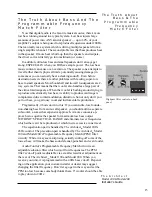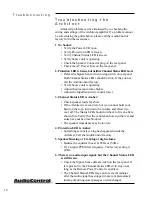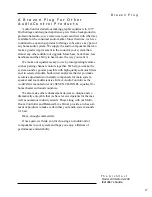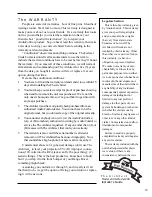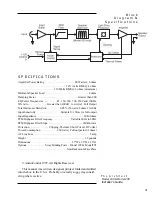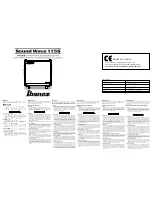
The Architect
Model 100 & Model 200
Installer’s Guide
Installation:
The Long
Version
7
Placement
The Architect Model 100 and Model 200 is a very efficient
amplifier, but it does need some breathing room to operate prop-
erly. Make certain that the air vents on the rear and sides of the
Architect are not blocked and have at least 1/2" of air space. Also
make certain that heat sensitive components such as CD or Tape
players are not directly on top of the Architect. Just as a reminder,
you should avoid putting any leaky potted plants on the audio
equipment stack.
A benefit of having remote power control on the Architect is
that you can install it in another area of the house (such as a
basement or utility room) away from the main component stack.
Make certain that you use a good quality audio line driver to
extend the RCA cables if you choose this type of installation.
Power
Under normal operating conditions, the Architect Model 100
or Model 200 can draw up to 500 watts of AC power. Don’t plug
it into a switched outlet on your system unless you are certain that
it can handle the power rating. Also, please don’t cut off the
ground pin on the power connector. It is an important safety
feature. If you need to plug it into a two prong outlet, use a
ground adapter (and connect the ground on it).
Remote Power Control
The Architect has three levels of power control:
1) Main AC Power switch- This is the master control and
must be turned ON for the Architect to function. When the main
power switch is on, the red Power LED on the front panel lights
up. Normally the only time that you would need to turn the AC
power switch off is when the system is going to be unused for an
extended period.
2) Remote Power Control- This removable 3-pin remote
connector on the rear panel allows simple interfacing with external
control systems. It accepts either a contact closure or ex12
volts DC. (see diagram) The two-color Protection LED on the
front panel illuminates Green to show that the remote power
control is active and the Architect is in Stand-by.
An Important Safety
Note About Ground
Loops and Ground
Isolation Switches
It’s an ugly fact: When you
wire a system and the electrons
have more than one choice for a
ground return, there is the
possibility of a ground loop
occurring. These loops can
manifest themselves as hum bars
in the video or pops and buzzes
in the speakers. Since electricity
always takes the path of least
resistance, systems designers
can try to force the ground
currents the direction they want
by improving the quality of the
grounds (lowering their resis-
tance) and using various
isolation techniques on the audio
and video equipment (raising
their resistance). Unfortunately,
one of the most common
isolation techniques is to cut off
the ground pin of the AC power
plug. NEVER CUT OFF THE
GROUND PIN. The chassis
earth ground is your protection
against the chance of line
voltage shorting to the enclo-
sure. Without this safety, your
body could become the path of
least resistance when you touch
the unit.
To provide necessary
isolation to safely break ground
loops, the Architect amplifiers
have a Ground Isolation switch.
This controls the resistance
between the audio signal ground
and the AC power earth ground.
Regardless of this isolation
switch setting, the chassis of the
Architect is ALWAYS connected
directly to earth ground.
Summary of Contents for Architect 100
Page 4: ......



















